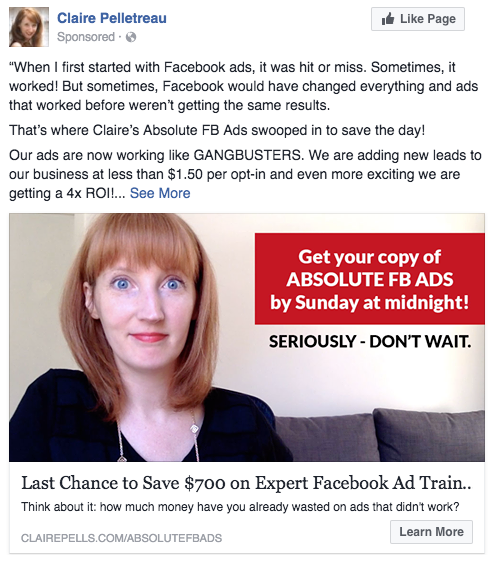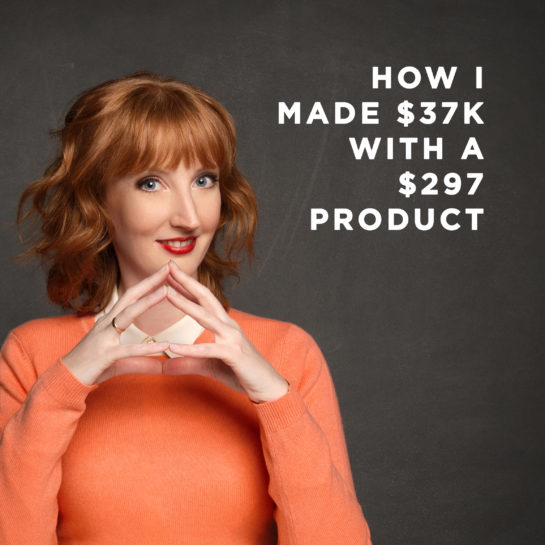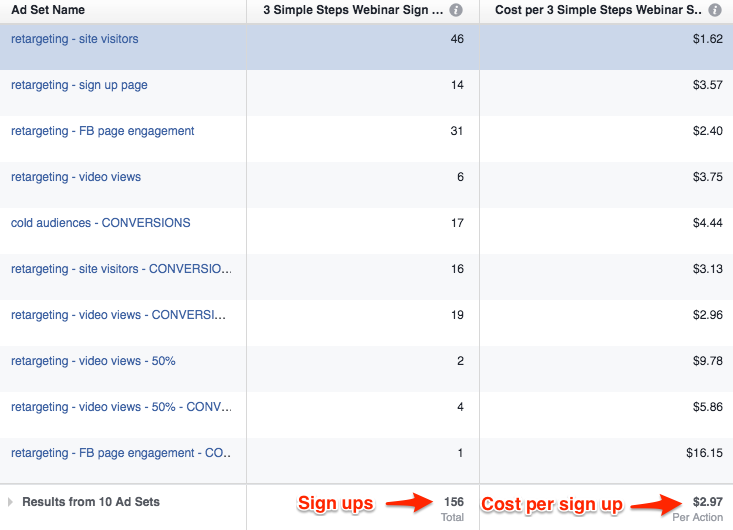You know what my favorite business blogs are?
The ones that go into detail about how they make their money. Especially people who lay out their entire launch plans, recap exactly what they did, and whether or not their strategies were successful.
I just wrapped up a launch in my own business, and I thought you might benefit from going behind the scenes with me as I discover for myself what worked and what didn’t. You’ll learn the strategies I used, what Facebook ads I ran, how much they cost, and how much revenue they brought in. (The title gave away my final revenue number, but that didn’t ALL come from paid traffic.)
And since I love oversharing being transparent, I’m not leaving anything out! So without further ado, here’s my launch post-mortem:
The goal:
To bring in a flood of new customers for my Facebook ads course, Absolute FB Ads before raising the price.
The last time I raised the price from $97 to $297, I sold more copies of the course than I had in any other launch. Price is a big motivator for people who are on the fence about purchasing something, so I expected sales to come in pretty easily this time around. And $297 compared to $997? Kind of a no-brainer for lots of people in my audience.
I used Nathalie Lussier’s “Good, Better, Best” goal-setting methodology. My sales goals were as follows:
Good: 50 courses sold.
Better: 60 courses sold.
Best. 70 courses sold.
These numbers were not really based on my list size or previous conversion rates (as they should have been). They mostly reflected how much money I wanted to make in order to 1) pay for the graphic designer and proofreader helping me to upgrade the course, and 2) to be comfortable during the month of May while I focused on a new method of selling. (More on that in a future post!)
What I did before and during the launch:
1. I re-started my list building ads in March.
To be honest, these ads weren’t 100% designed to increase my list before this promo. I had a new tripwire in place in my funnel, and I wanted to test how cold and warm traffic converted from a Facebook ad to a customer.
I also wanted to test out video ads for list building ads, so I put together a campaign and let it run. When I finally found the audience that was paying me more for the tripwire product than I was paying for ads, I let it keep running. I spent about $10 a day on those ads from mid-March to mid-April.
2. I worked with my coach to plan out every last detail of this launch.
This was HANDS DOWN the #1 reason for the success of this launch.
When it comes to selling anything in my business, I’m super lazy. I don’t like to work too hard on writing copy, doing outreach, pitching, the works.
But . . . since we’re being honest here, that “laziness” is just an excuse. It’s my excuse for being scared. Scared of the same thing lots of people fear when it comes to selling: fear of rejection, of disappointing people, of turning people off, of failure.
So my initial plan for this launch was to send out a few reminder emails, probably repurpose some old sales emails so that I wouldn’t have to worry about my sales copy being terrible, and maybe do a webinar.
(Webinars are like kryptonite for me: IT’S SELLING, LIVE AND IN PERSON! Nooooooooo!)
So when my coach, Barrett Brooks, suggested we do a session 100% dedicated to this sales push, I conceded. On April 11, with 3 weeks left for people to buy at the $297 price, we got on the phone to make a plan.
And boy, did we make a plan! Barrett made me write down every email I would send, the day I would send it, the topic of each, and the call-to-action to be included. Because I had those details nailed down, I didn’t have to think about what to send to my list, and when. I just consulted our plan every single day, and got to work.
Barrett also suggested that I get a co-host for my webinars in order to help ease my nerves. I thought “but who will give up that much time for me, for FREE???”
He told me to just f-ing ask some people, and gave me a deadline for getting a commitment. It turns out that people who like you will gladly help you out, free of charge. I asked two friends to co-host with me (one for each of the two webinar times), and they said “hell yes” immediately.
Finally, he forced me to come up with a simple worksheet that would help people engage more with my webinar and set them up to implement what they learned. Feeling like they’ve made real progress, he said, will make them feel more success as a result of what you’ve taught them.
We literally banged out the worksheet activities right there during our call. All I had to do was make it look a little prettier.
3. I reached out to friends and clients and invited them to join my customers as affiliates for the product.
I’ve had affiliates for my launches in the past, but this is the first time I provided them with swipe copy they could use to promote the course.
I also ended up doing 4 Q&A calls and webinars for affiliates and their communities. Those affiliates were the ones who sold the most . . . by a LOT.
4. I hosted two webinars on the same topic at two different times.
The webinar topic:
My last webinar was back in April 2015. Seriously – I was out of practice. But I knew that I could give away truly valuable strategies that would set people up for success, especially when they took my course to learn to implement them.
This was something that was missing from my last round of webinars: the information gap. In the past, I would pretty much teach everything, and then pitch the course. But why would they need to buy it if they got everything they needed in the webinar?
In the 3 Simple Steps to Double Your Course Sales with Facebook Ads, I taught people about what ads to run, and a bit about which target audiences to use. The real nuts and bolts of how to write the copy, which images to use, how to read the reports – all of that was missing in this webinar.
Where could they get it? My course. The pitch felt a bit more natural to me with this topic.
The webinar logistics:
People don’t attend webinars anymore. Or at least that’s what I feel like everyone on the internet is complaining about. So I decided to try out Facebook Live for my webinar platform, counting on the fact that Facebook would give it a nice wide reach and allow me to run ads to the replay.
So I wrote a blog post about it, embedded a Like button on it, told people to like my page to get notifications, and then offered a free worksheet to get people to actually sign up.
This resulted in 422 new Facebook fans in April, an 89% increase in Facebook post engagement, and 682 sign ups for the webinar. (Some of my affiliates emailed about my webinars, so I can attribute at least 15% of that growth to their traffic.)
I was hoping to use Belive.tv to do my Facebook Live sessions – it’s really simple to use and it allows you to bring other people on live with you as well. Unfortunately, at the time of the webinar, Belive didn’t offer a way to share your own screen or slides. (Apparently this feature is coming soon.)
So I upgraded my Crowdcast plan to be able to stream live on Facebook, invite a co-host on screen with me, and share my screen. (That plan costs $89 a month. I downgraded again when I was finished since I don’t plan on running any webinars this way in May.)
5. I sent out a lot more promotional emails than I have in the past.
Between April 6, when I officially announced the May 1 deadline to get my course at the $297 price, and April 30, I emailed my entire list a total of 8 times. These emails promoted the webinar and, once the webinar was over, there was a combo of hard and soft pitches for the course.
If you’re interested, you can see them all here.
NOTE: In the emails promoting the webinar, I got people who were a wrong fit for the course to self-identify. “If you own an e-commerce business, click here.” I set up a tag in Convertkit to be added to anyone who clicked on that link.
I then excluded them from future emails about both the webinar and the course, since I knew they wouldn’t convert to customers. In the future, I can send them very specific emails about offerings that are ideal for e-commerce entrepreneurs.
6. I ran a lot more Facebook ads.
In addition to list building ads I mentioned above, I also spent about $1500 on ads in April alone. They had a number of different objectives; here’s a breakdown of what I did.
- Content awareness ads. I spent about $250 promoting a video I had created about the right way to boost your post. I have never gotten so much traffic on an ad before; this post ended up getting 16K views, 31 comments, 88 likes/reactions, and 41 shares. Most of the comments were people tagging their friends or coworkers. I was thrilled!
- List building ads promoting the webinar. I mostly targeted my own list, fans and site visitors, but I also targeted people who had viewed my recent videos (including the Boost Post one mentioned above).
- Ads promoting the course. I targeted my site visitors, people who had viewed the webinar sign-up page, people who had engaged with my Facebook page recently, people who viewed my webinars, and people who had visited the course sales page.
What worked and what flopped with my ads:
a) My content awareness ads were a big fat FAIL. Nobody who saw it ended up buying. Despite the insane engagement on the video, I realized that the topic wasn’t specific enough to my course topic. The Boost Post button is used by errrrrrrrrrrrybody, not just course creators and coaches. My target audiences were just a little too broad and my video ended up capturing the interest of the wrong people. (NOTE TO SELF: there’s a big market for a mini course about the Boost Post button. But it ain’t my market.)
b) The webinar ads were solid! I got 156 signups for $2.97. This was my best-performing ad:

Here are the results from my different audiences:
In addition to the webinar sign ups, those ads resulted in about $1,670 in sales for a $460 ad spend. And even though my content awareness ads for this launch didn’t do well, prior video ads that I ran did end up helping. My most profitable audience for this particular campaign were people who had seen at least 50% of my recent videos:
c) Sales ads brought in the most sales – no surprise there. My most profitable audience in this campaign was full of people who had viewed the Absolute FB Ads sales page, as you can see here:
This is the ad that brought in the most revenue:

Here’s a shot of all the campaigns I ran in April (including a few not mentioned above), and how much revenue they ended up generating:
The Results of All Those Efforts Put Together
So did all of those things come together to help me reach my goals? Here’s a snapshot of the results of this launch:
List Growth:
List size on April 6: 4,068
New subscribers added: April 6-April 30: 532
People who unsubscribed: 289 (thanks for keeping my Convertkit bill low, you guys!)
List size on May 1: 4,306
Sales & Revenue:
Number of courses sold by affiliates: 38
Number of courses sold without affiliates: 86
Total number of courses sold: 124
Total revenue from launch: $36,828.00
Total revenue of all courses sold in April + projected revenue after payments: $37,517.00
Expenses:
Gumroad fees: $1,278.46
Commissions paid out to affiliates: $5,666.76
Paid to two VAs: $625
Investment in Facebook ads for March and April: $1,582.14
General operating costs of business for the month of April: $1,265.00
Total expenses: $10,417.36
Profit: $27,099.64
The verdict? Goals were SMASHED!
I’m really happy about the outcome of this launch, but I also like to think about what I would have done differently if I could go back knowing what I know now. A few ideas come to mind:
- Run a content awareness video ad specifically for coaches and course creators.
- Double down on the pre-launch list building ads.
- Run more ads to cold audiences for my webinars.
- Create a Facebook group for my affiliates in order to facilitate communication a bit better, and get them pumped up about promoting even more.
- Make the last day to buy a Tuesday, not a Sunday. It makes it easier to handle questions and purchase troubleshooting without asking my VAs to work on the weekends.
- Use a different system to manage my affiliates. I’ve heard great things about Thrivecart – apparently it’s like Samcart but way cheaper – but I can’t speak to their affiliate system.
What do you think? What have you learned from your own launches that you always implement (or completely avoid) when you’re launching now?
I’d love to hear about it in the comments below! Let’s overshare together. :)
Affiliate disclosure: some links contained in this post are affiliate links, and I may receive a commission if you end up becoming a customer. Just a heads up!















This is amazing stuff Claire! Thank you so much for sharing your insights. A true look inside is a great compliment to theory.
Thanks so much, Sandra! You’re absolutely right – theory will only get you so far. :)
EEEEEE I’ve been waiting for this all week! Congrats on such a successful launch :)
Thanks for sharing your insights, it’s making me rethink some of my client Ad Campaigns and my own campaigns going forward. :)
I would love to know, what was your audience size for retargeting your website visitors for the webinar ads and the audience size for sales page views 60 days?
Thanks so much, Sasha!
All website visitors: 21,000
Sales page views: 970.
Hope that helps!
Totally does, thanks. You get a tonne of traffic, is that mostly organic traffic?
Yes, by far my largest traffic source is organic search, but that doesn’t always mean it’s good quality traffic!
This is sooooooo helpful Claire! I will go through your post carefully…and study it. Thank you! :-)
My pleasure, Emily! Thanks for reading, as always. :)
Claire, I’ve been following you on your podcast practically since it first launched. Grabbed your course a couple of weeks ago and wanted to say “thanks” for the value you provide. I have been a marketing and advertising professional now for 16 years. You and I know there’s a lot of bullish*t out there from so called “experts.” So, thanks for keeping it authentic. And real. I’m looking forward to launching an online marketing training and tools hub to help small business with the madness of modern marketing. Glad I found your podcast, and your course to help me build an audience. Thanks again. Can’t wait for the updates.
Camilo, thank you SO much for your incredibly kind words. Have you dug into the updated version yet? I hope you love it as much as I do! :)
Great write-up Claire! I’ve got this sucker tagged to go back and study!
Aww, you’re the best Sean! Thanks for the high praise. :)
Awesome love the breakdown Claire and agree these are such valuable posts. Congrats on your launch success and I also appreciate the transparency that shows smaller numbers across some ads but ones that do still add up for a great ROI. I often think people expect hundreds or thousands of leads from ads
This was very useful Claire! Getting ready to launch my own course and this has given me a couple ideas :) Thank you!!
Thanks for sharing all the nitty gritty! This is my favorite type of post as well. :)